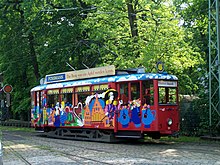First aid vehicle (tram)


The Association cars were following the guidelines of public transport operators association built tram - railcars and associated sidecar .
In the first years after the Second World War, large numbers of trams were made from war-damaged vehicles. These rebuilt trams are called body cars . Since the renewal of the heavily decimated wagon stocks at all tram operators was due, completely new vehicles had to be procured. This led to new designs of railcars (Tw) and sidecars (Bw), with the aim of standardizing and thus also simplifying tram construction in a time of economic shortage. This is how the first types of bandages emerged from 1950.
In contrast to the body wagons, which were built on chassis destroyed by the war, the 11 m long, two-axle first aid wagons were completely rebuilt. With the construction of the first aid car, the principle of the standard tram car (ESW) from 1938 was continued. With the modernization of the transport companies, the first up to 15 m long open- plan cars with passenger flow were purchased from 1952 , while further association cars were built until 1958. Basically two types of first aid cars were built, types I and II.
Bandage type I
The type I dressing was not entirely new. Its car body corresponded to the body car and was essentially based on the war tramcar (KSW) of the 1940s, but in contrast to this had four windows on each side. Depending on the company, it was built in different versions, some with sliding doors, some with automatic folding doors. Several companies converted their cars for one-man operation or for one-way operation. In addition to the mostly delivered two-axle wagons, so-called steering three -axle vehicles with three-axle chassis were also delivered to some transport companies.
Association type II
The association type II differs from the vehicles of the type I by some improvements in the box construction. Most noticeable are the inclined front windows and the solid aprons that almost completely cover the chassis. Type II was also built in different designs, such as with sliding or folding doors or for one- and two-way operation.
See also
- TF 50 - Association car of the West Berlin tram
literature
- Who comes too late ... - Association type tram. Part 1 . TRAM2000 edition 01.2002.
- From the end of an era - the first aid cars. Part 2 . SM edition 02.2002.